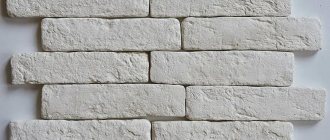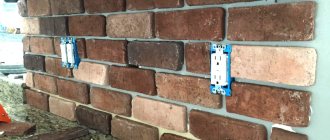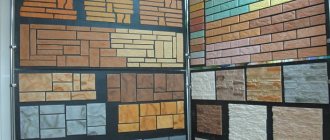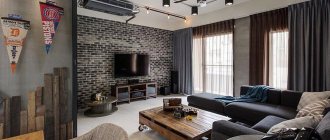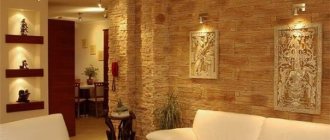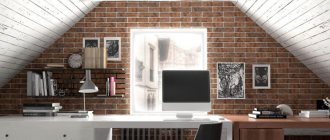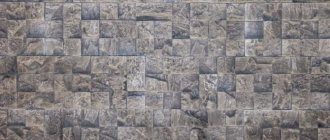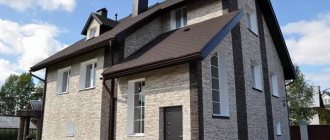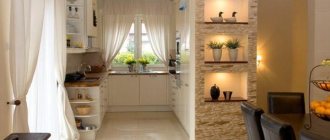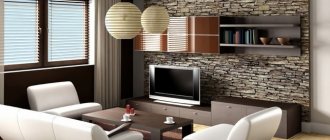Decorative facing bricks: types, application in the interior, installation rules
Decorative brick is a finishing material that comes in different shapes and sizes. There are two main types:
- For exterior decoration.
- For interior decoration.
The difference between these types lies in the conditions of use and size. External use imposes special requirements on the material, aimed at strength and reliability, resistance to atmospheric and mechanical influences. The decorative component for exterior work is not the main goal, although it is considered one of the main ones.
Decorative facing brick Source infenshui.ru
During interior work, the aesthetic effect of the material comes to the fore. The name “brick” itself reflects only the appearance of the cladding, which is, in fact, a tile that imitates natural stone or brickwork.
In accordance with the characteristics of the material, installation is carried out, which differs significantly from conventional masonry technology. The installation technique is as close as possible to the technique of laying tiles; the difference lies in the specific features of the selected material, the type of imitation and the height of the relief.
Use in interior decoration
Wall decoration with decorative bricks is used not only for the exterior design of buildings, but also for interior spaces, both residential and public. Ease of installation and external features allow the material to be used when finishing complex and non-standard surfaces. Using imitation brickwork, they highlight openings, arches, decorate architectural elements or make accents. Interior walls with imitation brick, painted in restrained natural tones: black, beige, white, gray or cream, look good.
Living room
Walls decorated with brickwork look original and very beautiful. This decoration fits especially harmoniously into styles: modern, grunge or industrial (loft). Such an accent wall can serve as an excellent backdrop for placing a large TV, unusual panels, futuristic paintings and designer furniture.
Dining room, kitchen
Here, in addition to the aesthetic appearance, such properties of the coating as durability and practicality are exploited. A kitchen apron made of decorative brick tolerates humidity and temperature changes well, and is easy to clean. Over time, it does not lose its original attractiveness. Brick looks good in modern and classic styles.
Bedroom
Designers recommend using this material in the bedroom interior in small quantities (for example, to highlight window and door openings, to decorate an accent wall at the headboard or opposite it). It can be a brutal loft interior or a charming eclecticism, a play on contrasts. In this case, rough brick contrasts with elegant furniture and delicate textiles of curtains and bedspreads.
Main types of imitation brick for interior decoration
There are different options for simulating brick or stone masonry:
- Brick wallpaper
- Plastic panels , basement siding.
- Clinker tiles .
- Stone or brick tiles made of porcelain stoneware .
- Brick-like gypsum tiles.
- Flexible tiles.
The choice of one option or another is dictated by the capabilities of the owner, the specifics and features of the premises, and other considerations.
Great importance is attached to the aesthetic content, which will create a canvas from the selected material Source satu.kz
Different types of decorative material
The most realistic imitation occurs when using clinker tiles, which are made using the same technology as clinker bricks and differ from it only in the width of the briquette.
It can be used for both interior and exterior work and can withstand any impact Source inforem.ru
See also: Catalog of companies that specialize in interior redevelopment.
Plastic panels are a budget cladding option, although some types allow you to get a completely realistic and attractive surface.
Installation is simple, the work consists of fastening the panels with screws Source mtlarena.ru
Brick wallpaper is the easiest and fastest way to solve the problem, which does not require much labor.
The result usually looks commensurate with the money invested Source bigl.ua
Flexible tiles are made from sand-pigment compounds applied to an elastic base. The material has excellent performance qualities and can be used indoors, on terraces or balconies. Very realistically imitates a natural brick surface. It is used both for complete wall cladding and for partial application, the formation of point decorative elements.
Flexible tiles Source mogilev.adiso.by
Gypsum tiles make it possible to obtain a light, non-excessive surface that successfully replicates a real brick wall. Recommended for finishing frame houses and light buildings sensitive to additional load.
Gypsum tiles Source plotnikov-pub.ru
Artificial brick
Artificial brick is the collective name for a group of materials that represent cladding for indoor or outdoor use. Most of them have a pronounced decorative purpose, allowing for various options for interior decoration and are not intended to create mechanical protection.
All types of artificial brick have a surface that imitates masonry from various types of natural materials Source roomester.ru
Artificial stone for brick
Decorative stone “brick” is a popular material for exterior and interior decoration. It has many options for texture, color and size of tiles, allowing you to create both a uniform and combined coating. Recommended for cladding the walls of large rooms, halls, wide corridors and recreation areas.
Suitable for decorating hotel lobbies or other public places Source mcxtyva.ru
Gypsum brick, decorative cement brick
Gypsum and cement types of decorative bricks are budgetary types of cladding. They are popular because of their low cost and the ability to create the material yourself. A special feature of the material is the ability (sometimes the necessity) to paint a finished canvas with worn seams in the desired color. The ease of manufacture is at the same time a disadvantage, since there are many artels engaged in the handicraft production of such materials that do not have the required quality and basic strength. When deciding to use gypsum or cement artificial brick, you should carefully study the documentation for the material.
Budget type of cladding Source tanki-pro.ru
Architectural and design solutions for interior design
Modern technologies and the widest range of raw materials, dyes and shapes make it possible to give decorative bricks for interior decoration a variety of sizes, colors and shades. This, in turn, allows you to design and implement a huge number of decoration elements, starting with individual parts of rooms and ending with interconnected interiors of individual rooms for the entire house.
The owners themselves can decide how certain rooms inside the house will look, how to decorate the fireplace or entrance areas. But it’s still better to consult with specialist designers. People with special education and experience in this matter will help you choose the facing material depending on the size of the rooms and the location of the lighting sources. They will take into account the general layout of the building, the level of humidity and areas with possible temperature changes and, most importantly, the color preferences of the inhabitants of the home for common areas and for each personal room, be it a bedroom or an office.
Decorative brick in the interior: choosing a style
Choosing the most attractive option is a difficult creative task. It is necessary to decide on the choice of color, type of finish, material and other items that determine the overall result. It is important to keep in mind that a brick wall creates a strong impact on the human psyche; if the parameters are not carefully chosen, it can exert psychological pressure and “hang” over the residents of the house.
If you have doubts about your project, or there are no fresh ideas, you can turn to specialists or look for inspiration on the Internet. There are a great variety of different photographs or pictures with room design options on the Internet, which allows you to choose the most preferable option.
Photos of ideas for using decorative bricks in the interior
A special feature of the material is the ability to use different design finishing techniques.
You can make decorative brick the main type of wall cladding Source archidea.com.ua
Many owners prefer to define their style by covering only one wall, usually the largest in area Source tiposot.spb.ru
As an option, decorative bricks are partially installed, which does not occupy the entire plane of the walls and creates a combined type of finish Source plotnikov-pub.ru
Styles suitable for brickwork
First of all, brick cladding is associated with the loft style. Nowadays, industrial style or imitation bohemian housing has moved into ordinary apartments. Imitation of aged brick masonry can be used as an interior accent, to highlight the area behind the bed or sofa, decorate niches, etc.
Another style that fully allows the use of bare brick is country style, which creates the atmosphere of a hunting hut, a cottage outside the city, or the “house in the village” familiar to everyone from advertising. The brick-lined area of the stove or fireplace turns out to be especially interesting and functional. The combination of a “raw” surface with natural wood and textile elements made from shreds and “grandmother’s” cotton fabric also has a peculiar charm.
The material has also found application in interiors made in the Gothic and Neo-Gothic styles. They reproduce the atmosphere of feudal castles with numerous columns and pointed arches. Imitation brick is perfect for their design. A chic chandelier with numerous crystal pendants or a giant four-poster bed create a magnificent contrast with the ascetic brick.
By the way, about asceticism. Decorative brick cladding harmonizes perfectly with elements of minimalism. The combination of red, egg, brown or terracotta brick with furniture in neutral colors is especially beautiful.
Self-installation of decorative bricks
Typically, the installation of decorative bricks is entrusted to specialists with experience in such work. They work quickly and efficiently, they know the features and properties of the material. However, often the presence of strangers in the house is undesirable for some reason, or the owner of the property does not have the opportunity to provide access to the premises during working hours. Then you have to solve the issue yourself by laying the tiles under the brick at a time convenient for you. This option is quite accessible, although it requires some skills in handling such materials.
Installation of flexible bricks, installation of rigid bricks
The installation technique for rigid and flexible types of decorative bricks has some differences. Laying hard types of material is almost similar to the technology for installing tiles - an adhesive composition is applied to the surface of the wall and/or to the back side of the tile, then it is applied to the wall and lightly pressed.
A convenient point is that there is no need to precisely adjust the angles, which allows people with minimal experience to work Source pdhl.co.uk
Installation of flexible tiles is carried out on a thin adhesive layer. It is necessary to pay attention to the even line of the seams and the horizontal line; this will allow you to create a neat and geometrically correct cladding fabric. The corners are not adjusted, the tiles are simply bent around the corner, making the appearance of the canvas more natural and seamless. The seams are smoothed or painted with a thin brush.
There is no need to grout the seams, which significantly speeds up and simplifies the work Source plotnikov-pub.ru
Properties and range of applications
Decorative brick resembles natural stone in properties, and ceramic tiles in appearance. The material is made from environmentally friendly natural materials, after which it is subjected to an invoicing procedure. This process allows you to obtain different textures, shades, and patterns.
The very concept of “decorative brick” includes 2 groups of finishing materials:
- Natural brick - most often used for facade decoration.
- Artificial brick - used for interior wall decoration.
Option for interior wall decoration Source www.dizainvfoto.ru
The functions of materials from both groups are approximately the same, but the products themselves differ in the raw material base and performance characteristics. The technologies used make it possible to provide a number of important physical properties that make the material so popular:
- durability - the service life of the material is about 40 years, during which the appearance and performance properties are preserved;
- strength;
- fire safety - the product does not burn, therefore it is often used for lining fireplaces and stoves;
- resistance to aggressive environments, chemicals, temperature changes;
- thermal insulation properties that allow you to maintain a comfortable microclimate in the room;
- versatility and high aesthetic data. Different geometries, shapes, patterns, sizes of decorative bricks for interior wall decoration allow you to create any architectural elements in the interior;
- good sound insulation;
- water-repellent properties that protect the wall from moisture.
Imitation of white brick Source yandex.net
All of the listed advantages allow you to use decorative brick in almost any room. The scope of use is one of the widest on the market for finishing materials - finishing surfaces in the bedroom, living room, kitchen, corridor, bathroom, dining room, office and public spaces. Moreover, matte, glossy, and embossed surfaces of the material are equally popular.
Decorative brick, price
The cost of decorative bricks depends on the type of material, raw materials for its production, country and manufacturing company, and other factors. The costs of the material are quite high, especially if it is imported and of high quality. Since everything depends on the financial capabilities of the user purchasing decorative bricks, the price is of great importance. The unit of material measurement is 1 package or 1 m², which does not always correspond to each other. The cost of inexpensive types of artificial brick is about 600 rubles/m², and expensive imported types can cost 9000 rubles/m², which for large areas will be an impressive amount.
Execution of work
Should I buy ready-made decorative bricks for interior decoration or make them myself, cover the walls with them myself, or contact companies specializing in providing such services? The decision about this should be made depending on the presence or absence of your own skills and abilities and financial capabilities. The time factor is of no small importance. In any case, you need to understand that specialists will complete the work faster and with better quality.
If you decide to do everything yourself, then when selecting raw materials, it makes sense to listen to the advice and recommendations of sales consultants. Having all the information about the products offered, they will help you better select components for making bricks, adhesives, mastics, molds, dyes and tools so that the work does not cause unnecessary surprises and disappointments. You can also consult with them regarding technologies for preparing forms, mixing mixtures, terms and conditions for drying bricks and sticking them on surfaces intended for cladding.
Helpful information! If the retail outlet cannot answer the questions asked, then it makes sense to go to another store where they will give full advice.
In the case when it is decided to entrust the work to specialists, the customer is responsible for the issues of project approval, financing and control over the quality and timing of the work.
The price of decorative bricks for interior decoration depends on many factors. This is both the raw material and its quality. These are production technologies and the “brand” of the manufacturer. Trade margins and discounts for quantity purchased also play a role.
For comparison, you can see the prices for individual collections from some manufacturers.
Table 1. Average cost of decorative bricks
| Image | Manufacturers | Name of collections | Price RUR per 1 m² |
| Group | Slimbrick | from 997.1 | |
| AnticBrick | from 1121 | ||
| KAMROK-PRO LLC | Antique brick | from 700 | |
| Hanseatic brick | from 700 | ||
| Clinker brick | from 700 | ||
| Romanesque brick | from 800 | ||
| Old brick | from 700 | ||
| Bergen | from 940 | ||
| Bruges | from 940 | ||
| Bremen | from 890 | ||
| Paris | from 890 | ||
| Louvre | from 940 |
In one article it is impossible to cover the entire palette of prices and collections for this facing material. Moreover, each collection includes several sets, differing in shades of colors from the lightest to almost black.
Helpful information! When coordinating design solutions for each room and interior element, it is necessary to take into account the availability in the nearest shopping centers of affordable and quality material offered by designers or the possibility of supplying it to order. Then the work will be completed on time and its cost will not greatly exceed the estimate.
